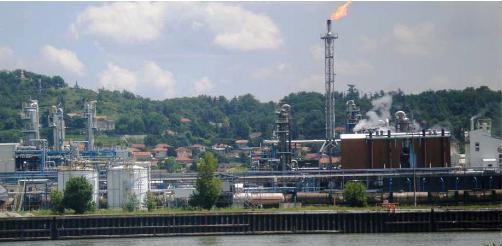The complex process of manufacturing methionine

Companies harness nature to make feed amino acids via fermentation, but the presence of a sulphur atom has thwarted a similar approach for methionine. Instead, it is made via a complex chemical synthesis involving hard-to-handle raw materials such as methyl mercaptan, propylene and hydrogen cyanide. Manufacturer Adisseo recently offered a look behind the scenes to show what constraints cross their path at their plant in Les Roches de Condrieu, south of Lyon in France.
Methionine (Met) is defined as an essential -amino acid, because it cannot be synthesised by mammals and has to be ingested through food. As the methionine content in raw plant materials is insufficient, synthetic methionine complements must be added to animal feed. In animal diets it is the second limiting amino acid after lysine and in poultry it is even the first limiting one. Where lysine can be produced by bacteria via a relatively simple fermentation process, methionine has to be constructed chemically from mineral and organic derived compounds. Together with cysteine, methionine is one of two sulphur-containing proteinogenic amino acids. Methionine is an intermediate in the biosynthesis of cysteine, carnitine, taurine, lecithin, phosphatidylcholine, and other phospholipids. Non-essential L-cysteine can only be synthesised by the body from L-methionine, and when methionine is in short supply cysteine will become an essential amino acid too.The production site of Adisseo in Les Roches, France is the heart of the company’s European methionine production and makes sulphur products (sulphuric acid and carbon disulfide) and Methionine MMP (methyl mercaptan-propionaldehyde, the first intermediate in the synthesis of methionine). Figure 1 gives a schematic overview of the production of methionine and the materials involved. As can been seen, the basic products are derived from the petrochemical industry. Once MMP is established it is transported through an 11 kilometre long pipeline to a production plant in Roussillon where it is converted to DL-methionine.
All current methionine manufacturers have a similar production process, but the level of upstream integration varies. Adisseo has all stages of production in its own hands, but some producers, for example, acquire MMP from the petrochemical industry. Since most constituents are dangerous products, safety is a main issue at the production units and Adisseo has very strict safety rules on the production sites.
Massive and secured logistics
The production process of methionine requires six main raw materials: sulphur, methanol, ammonia, propylene, sulphuric acid and energy (gas – CH4). The long chain of process steps is limited by the weakest step. Raw materials and intermediates have to be available in quantity and on time, since the plant is running 24/7 every day of the year. This can be complicated since raw material storage capacities are limited; meaning that logistics are a big issue, as well as maintenance of the plant. Adisseo’s purchasing division has secured its raw material supply through partnerships with major players in the chemical and oil industry.
To secure supply there are always two means of transport for a product. Methanol comes by boat, from major plants around the world, to the company’s 20,000t Marseilles storage. Final supply to the plants is by barge along the Rhone River with truck transport as a backup. Sulphur comes by block train and trucks. Propylene is delivered through a pipeline from the Feyzin refinery and by rail. Ammonia and sulphuric acid are delivered mainly by block trains with trucks as a backup.
Propylene problems
Propylene is the main strategic raw material for methionine production. Adisseo has 30,000 tonnes underground storage for propylene that is filled by a pipeline. The two main sources of propylene are a byproduct from the steam cracking of liquid feedstocks such as naphtha as well as LPGs, and from off-gases produced in fluid catalytic cracking (FCC) units in refineries.The primary source of propylene is from cracking naphtha and other liquids such as gas oil and condensates to produce ethylene. By altering the cracking severity and the feedstock slate, the propylene:ethylene ratio can vary from 0.4:1 to 0.75:1. A growing source of propylene, particularly in the US, is from refineries where splitters recover the propylene from the off-gases produced by FCCs. However, refinery propylene needs to be purified for chemical and polymer use. New catalysts are now available that increase propylene output from the FCCs.
With propylene demand growing faster than ethylene, combined with the building of more ethane crackers (which produce no propylene) rather than naphtha crackers, on-purpose technologies are being employed increasingly to make propylene. Propylene production thus depends heavily on ethylene production. In their quest for more independent energy supply the use of shale gas has completely changed the American market. US crackers – who are more flexible than the European one’s – jumped on the opportunity to run on this cheap energy supply. But shale gas does not contain C3 which is needed for propylene production and the crackers’ output has shifted towards ethylene. Because of this, the American market is struggling for propylene and prices in the US are 20% higher than in the rest of the world. This is probably a structural and lasting change.
In Europe, production will remain constrained, whereby cracker operation will continue to be driven by ethylene demand. Imports of polyethylene (PE) and glycol (MEG) from Middle East will affect local production. Refinery operations will be affected by restricted gasoline demand and low profitability. Western Europe currently has no plans to further increase on-purpose propylene production. Import volumes will remain difficult to source and logistics will be the key.
Sulphur dependence
As a basic and essential raw material for the production of methionine, sulphur has evolved from waste material to key raw material status. Sulphur represents the third value for methionine just behind natural gas (no.2) and propylene (no.1). In the past five years the market has changed dramatically and prices skyrocketed in 2008 from $50-60 per tonne to over $800 per tonne. Since then prices have come down, but the market remains volatile and higher than before 2008. Because sulphur is a by-product from chemical processes, production is neither demand nor price driven. Demand for sulphur however is mainly driven by fertiliser use, which is increasing on a world level. A short market is expected to remain until 2015 when some petrochemical works come into production and supply should increase.Sulphur is a special product; it is an inflammable and corrosive liquid, with a 120SDgrC solidification point. This requires specific and dedicated logistics. There are two forms of sulphur on the market: liquid, which has a 7% share by volume of the world market, but 95% of the European market and a solid sulphur market (93%). World market use is about 50 million tonnes per year.
Adisseo is the largest sulphur consumer in France, which is used at the Les Roches plant, where it can be unloaded in its liquid form only. It is supplied in heated rail carts to keep it liquid. Main sulphur sources for Les Roches are the Leuna (Germany) refinery, French refineries, the Lacq (France) gas field and other spot sources. The European market is becoming tighter, which is almost 100% liquid methionine. There is the reduction and forecasted closure of the Lacq gas field; the German BEB gas field is declining and European refinery capacity has a 20% excess which should induce ‘go slow’ and some refineries to shut down. Demand for sulphur, however is strong. The French market will be the most severely hit (the Lacq shut down alone removes 300,000 tonnes), going from net exporter to net importer. To encounter these threats on the sulphur market Adisseo is considering three options: (1) look for access to new sources of liquid sulphur, (2) invest in re-melt capacity in Les Roches and (3) get access to a solid sulphur terminal and a re-melt capacity in a harbour. The latter decision has already been made and a project has been started in a harbour to secure future sulphur supply. Start-up is planned in mid 2012.
Biofermentation
Industrially produced methionine mainly consists of DL-methionine, which is produced through chemical synthesis. When L-methionine is required, it is provided by acetylation of DL-methionine. For the production of L-methionine by fermentation, methods utilising an L-methionine analogue-resistant mutant strain of bacteria have been reported. However, their production amount is small, and factors affecting the L-methionine production have not been elucidated yet. Therefore, L-methionine is still one of the amino acids which is the most difficult to produce by fermentation.
French Metabolic explorer (MetEx) owns patents for the enhancement of an E. coli strain for the production of methionine. French starch and animal feed maker Roquette owns patents for extracting L-methionine from fermentation broth. This process leads to 85-95% pure L-methionine. Roquette in 2009 started broiler trials using a feed including MetEx methionine. These tests would at least take 18-24 months so results might be expected by the end of this year. Japanese feed additive maker Ajinomoto in 2009 has also filed patents for a method for producing L-methionine with the use of a recombinant E. coli bacteria. French chemical maker Arkema and South Korea’s CJ CheilJedang are partnering to build the world’s first commercial facility to produce methionine from renewable resources. The facility, to be built in Malaysia, will have capacity to produce 80,000 metric tonnes per year of L-methionine, mostly from plant-based raw materials. It is expected to cost $400 million, split equally between the partners, and open by the end of 2013.Profitability of such a plant would depend on the cost of glucose, which is the main growth medium for the bacteria. There is also co-production of succinic acid and/or acetic acid, which may be valued separately. Assuming forward yields and glucose cost, at this moment none of the two processes seem to have an advantage over synthetic methionine production.
Adisseo at a glance Adisseo designs, develops, and produces vitamins, enzymes and methionine, including powder methionine and hydroxy analog liquid methionine. The company has regional centres in Antony (France), Atlanta (GA, USA), Sao Paolo (Brazil), and Singapore, as well as production facilities in Commentry, Les Roches, and Roussillon (France), Burgos (Spain), and Institute (WV, USA). |











